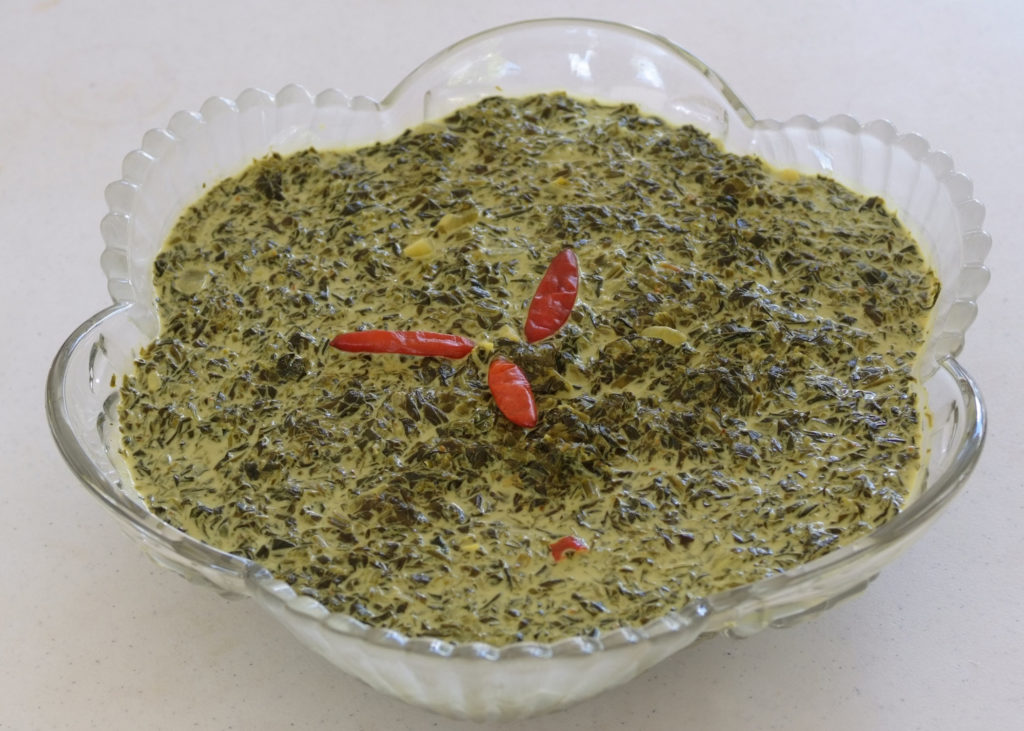
Description
Taro leaves prepared in the cream produced by squeezing grated fresh, ripe coconut with water to make lechen niyok, or coconut cream, seasoned with turmeric and lemon juice.
History
Origin
The use of “lechen niyok” is an indigenous cooking method used in Southeast Asia and tropical Pacific islands. This method can also be found in African countries and the Caribbean islands wherever the coconut is available. The addition of lemon juice creates a taste combination common in the preparation of many vegetables and protein dishes. This flavor combination can also be found in lechen beringhenas (creamed eggplant) or in tinaktak (chopped beef). Turmeric (orange ginger root) adds a distinctive yellow color as well as further flavor enhancement. “Gollai” means vegetable; “hågon” means leaf, and “suni” is the Chamorro word for taro. “Gollai” can be used as a verb such as “ma gollai” as in the cooking activity; as well as a noun to describe the dish. “Gellai” is another version used according to the context of the sentence.
Evolution
Gollai hågon suni has persisted as a basic cooking method probably as early as the first migrations from Southeast Asia. Taro (suni) plants were brought to the Marianas with the first settlers, as was the turmeric, or red ginger root.
Lemon was grown in the Mariana Islands prior to the arrival of Europeans. Other plants used for the sour taste would be tuba vinegar, made by fermenting coconut sap, or tamarind leaves or unripe seeds (kamalendo’). Filipinos who were in the Marianas as early as the 17th century, showed CHamorus how to process coconut sap to get tuba, fermented coconut sap, that turns into a vinegar when aged.
Contemporary cooks often add other vegetables such as chopped green beans to the mixture. Spinach, either fresh or canned, is a common substitute for taro. Gollai hågon suni has become a popular fiesta food because of its palatable flavor which complements the more bland starch or mildly-flavored fish dishes.
Preparation
Leaves of the dry-land variety of taro are picked, washed, and blanched by immersing them in boiling water for about a minute. This changes the chemistry of the leaf to eliminate the irritant which makes one’s skin itchy. The leaves are then chopped, along with onions, garlic, and other greens if desired. Spinach may be substituted for taro. The onions and garlic are usually fried to release more flavor, then leaves and other greens added with a little water. The mixture is cooked with enough water to keep the mixture moist, stirring often until thoroughly cooked. Fresh, grated turmeric or the powdered version is added during the cooking process, and seasoned with salt to taste. Chefs might use mango’, or yellow ginger, instead of tumeric. Hot peppers may be added according to taste. When the mixture is thoroughly cooked, lemon juice and lechen niyok (coconut cream) are added.
Placement on table
Gollai hågon suni is placed with other vegetable dishes towards the end of the main table, after the totche dishes, which refer to the protein dishes. The starches, or åggon, dishes lead the table.
Recipe
Gollai Hågon Suni: Taro Leaves in Coconut Cream
- 3-12 ounce cans of spinach or 4 cups of fresh spinach
- Coconut milk
- Water
- 1 teaspoon salt
- Onions, chopped
- Garlic, chopped
- 2 tablespoons turmeric
- Lemon juice
- Hot peppers, optional
As in many traditional recipes, proportions are not exact and depend on the experience and tastes of the cook. Usually cooked in large quantities, the following proportions may be adjusted accordingly: It takes experimentation to determine how many fresh taro leaves equal a 12 ounce. can of cooked spinach. Prepare the fresh leaves as described above, adding it or spinach to the fried onions and garlic. The equivalent of three 12 ounce cans of spinach can be cooked with the “lechen niyok” made from two coconuts with 8-10 ounces of water added. A 12 ounce can of commercially-prepared coconut milk may be substituted. Add a teaspoon salt, 2 tablespoons of turmeric, and hot peppers if desired. Add about ½ cup of fresh lemon juice (more or less to taste) and about 12 ounces of lechen niyok, as described above, as soon as the mixture is thoroughly cooked and removed from the heat.
* Recipe by Judy Flores, PhD
